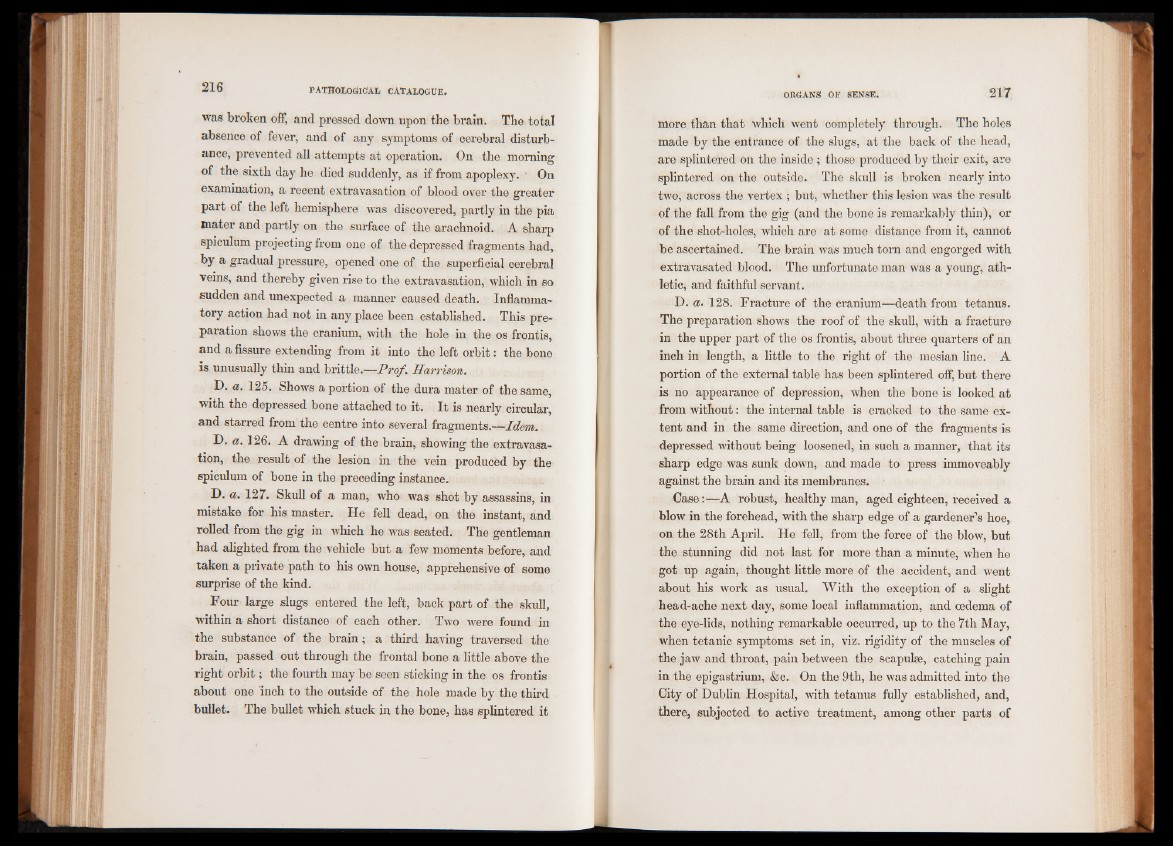
was broken off, and pressed down upon the brain. The total
absence of fever, and of any symptoms of cerebral disturbance,
prevented all attempts at operation. On the morning
of the sixth day he died suddenly, as if from apoplexy. ' On
examination, a recent extravasation of blood over the greater
part of the left hemisphere was discovered, partly in the pia
Inater and partly on the surface of the arachnoid. A sharp
spiculum projecting from one of the depressed fragments had,
by a gradual pressure, opened one of the superficial cerebral
veins, and thereby given rise to the extravasation, which in so
sudden and unexpected a manner caused death. Inflammatory
action had not in any place been established. This preparation
shows the cranium, with the hole in the os frontis,
and a fissure extending from it into the left orbit: the bone
is unusually thin and brittle.—Prof. Harrison.
D. a. 125. Shows a portion of the dura mater of the same,
with the depressed bone attached to it. It is nearly circular,
and starred from the centre into several fragments.—Idem.
D. a. 126. A drawing of the brain, showing the extravasation,
the result of the lesion in the vein produced by the
spiculum of bone in the preceding instance.
D. a. 127. Skull of a man, who was shot by assassins, in
mistake for his master. He fell dead, on the instant, and
rolled from the gig in which he was seated. The gentleman
had alighted from the vehicle but a few moments before, and
taken a private path to his own house, apprehensive of some
surprise of the kind.
Four large slugs entered the left, back part of the skull,
within a short distance of each other. Two were found in
the substance of the brain; a third having traversed the
brain, passed out through the frontal bone a little above the
right orbit; the fourth may be seen sticking in the os frontis
about one inch to the outside of the hole made by the third
bullet. The bullet which stuck in the bone, has splintered it
more than that which went completely through. The holes
made by the entrance of the slugs, at the back of the head,
are splintered on the inside ; those produced by their exit, are
splintered on the outside. The skull is broken nearly into
two, across the vertex; but, whether this lesion was the result
of the fall from the gig (and the bone is remarkably thin), or
of the shot-holes, which are at some distance from it, cannot
be ascertained. The brain was much tom and engorged with
extravasated blood. The unfortunate man was a young, athletic,
and faithful servant.
D. a. 128. Fracture of the cranium—death from tetanus.
The preparation shows the roof of the skull, with a fracture
in the upper part of the os frontis, about three quarters of an
inch in length, a little to the right of the mesian line. A
portion of the external table has been splintered off, but there
is no appearance of depression, when the bone is looked at
from without: the internal table is cracked to the same extent
and in the same direction, and one of the fragments is
depressed without being loosened, in such a manner, that its
sharp edge was sunk down, and made to press immoveably
against the brain and its membranes.
Case:—A robust, healthy man, aged eighteen, received a
blow in the forehead, with the sharp edge of a gardener’s hoe,
on the 28th April. He fell, from the force of the blow, but
the stunning did not last for more than a minute, when he
got up again, thought little more of the accident, and went
about his work as usual. With the exception of a slight
head-ache next day, some local inflammation, and oedema of
the eye-lids, nothing remarkable occurred, up to the 7th May,
when tetanic symptoms set in, viz. rigidity of the muscles of
the jaw and throat, pain between the scapulae, catching pain
in the epigastrium, &c. On the 9th, he was admitted into the
City of Dublin Hospital, with tetanus fully established, and,
there, subjected to active treatment, among other parts of